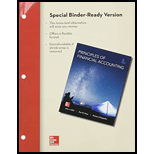
Concept explainers
1.
Compute the departments’ equivalent unit of production when all direct materials are added to products when processing begins.
1.
Explanation of Solution
Equivalents units for production (EUP): Equivalents units are a measure of the work done during an accounting period. It includes the beginning and closing inventory of work in process and they also provide information relating to work on units that are completely processed during the period. The Equivalents units for production (EUP) under FIFO method is computed as follows:
Determine the equivalent unit of production when all direct materials are added to products when processing begins.
Given, the Beginning inventory is 100% complete with respect to materials and the ending inventory is 100% complete with respect to materials.
| EUP for Materials | Units of Product |
| To complete Beginning work in process | 0 |
| Units started and completed | 56,000 |
| Ending work in process | 16,000 |
| Total Equivalent Units of Production | 72,000 |
Table (1)
2.
Compute the departments’ equivalent unit of production when beginning inventory is 40% complete and ending inventory is 75% with respect to materials and conversion costs.
2.
Explanation of Solution
Equivalents units for production (EUP): Equivalents units are a measure of the work done during an accounting period. It includes the beginning and closing inventory of work in process and they also provide information relating to work on units that are completely processed during the period. The Equivalents units for production (EUP) under FIFO method is computed as follows:
Determine the equivalent unit of production when beginning inventory is 40% complete and ending inventory is 75% with respect to materials and conversion costs.
Given, the Beginning inventory is 40% complete with respect to materials and the ending inventory is 75% complete with respect to materials.
| EUP for Materials | Units of Product |
| Beginning work in process | 14,400 |
| Units started and completed | 56,000 |
| Ending work in process | 12,000 |
| Total Equivalent Units of Production | 82,400 |
Table (2)
Note:
3.
Compute the departments’ equivalent unit of production when beginning inventory is 60% complete as to materials and 40% complete as to conversion costs and ending inventory is 30% complete as to materials and 60% complete as to conversion costs.
3.
Explanation of Solution
Equivalents units for production (EUP): Equivalents units are a measure of the work done during an accounting period. It includes the beginning and closing inventory of work in process and they also provide information relating to work on units that are completely processed during the period. The Equivalents units for production (EUP) under FIFO method is computed as follows:
Determine the equivalent unit of production when beginning inventory is 60% complete as to materials and 40% complete as to conversion costs and ending inventory is 30% complete as to materials and 60% complete as to conversion costs.
Given, the Beginning inventory is 60% complete with respect to materials and the ending inventory is 30% complete with respect to materials.
| EUP for Materials | Units of Product |
| Beginning work in process | 9,600 |
| Units started and completed | 56,000 |
| Ending work in process | 4,800 |
| Total Equivalent Units of Production | 70,400 |
Table (3)
Note:
Want to see more full solutions like this?
Chapter 20 Solutions
Principles of Financial Accounting, Chapters 1-17 - With Access (Looseleaf)

 AccountingAccountingISBN:9781337272094Author:WARREN, Carl S., Reeve, James M., Duchac, Jonathan E.Publisher:Cengage Learning,
AccountingAccountingISBN:9781337272094Author:WARREN, Carl S., Reeve, James M., Duchac, Jonathan E.Publisher:Cengage Learning, Accounting Information SystemsAccountingISBN:9781337619202Author:Hall, James A.Publisher:Cengage Learning,
Accounting Information SystemsAccountingISBN:9781337619202Author:Hall, James A.Publisher:Cengage Learning, Horngren's Cost Accounting: A Managerial Emphasis...AccountingISBN:9780134475585Author:Srikant M. Datar, Madhav V. RajanPublisher:PEARSON
Horngren's Cost Accounting: A Managerial Emphasis...AccountingISBN:9780134475585Author:Srikant M. Datar, Madhav V. RajanPublisher:PEARSON Intermediate AccountingAccountingISBN:9781259722660Author:J. David Spiceland, Mark W. Nelson, Wayne M ThomasPublisher:McGraw-Hill Education
Intermediate AccountingAccountingISBN:9781259722660Author:J. David Spiceland, Mark W. Nelson, Wayne M ThomasPublisher:McGraw-Hill Education Financial and Managerial AccountingAccountingISBN:9781259726705Author:John J Wild, Ken W. Shaw, Barbara Chiappetta Fundamental Accounting PrinciplesPublisher:McGraw-Hill Education
Financial and Managerial AccountingAccountingISBN:9781259726705Author:John J Wild, Ken W. Shaw, Barbara Chiappetta Fundamental Accounting PrinciplesPublisher:McGraw-Hill Education





